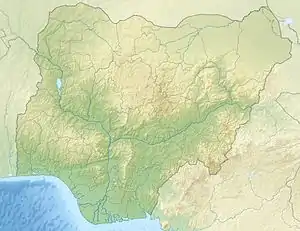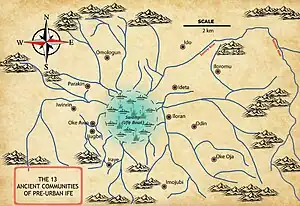Oke Ora
Oke Ora (Yoruba: Òkè Ọ̀rà) is an ancient community and archaeological site situated on a hill about 8 km (5 miles) east of Ilé-Ifẹ̀, in between the city and the small village of Itagunmodi. It is known as the origin of two characters in the early history of Yorubaland; Odùduwà and Oranife/Oramfe. Several stories and myths of the Yoruba people surround the site, and today, it continues to play an important role in certain religious rites of the Ifẹ̀ people, most siginpificantly, in the coronation rituals of the Owoni (Ooni), king of Ifẹ̀.[4][5]
Òkè Ọ̀rà | |
 Shown within Nigeria | |
| Location | Ilode II, Ife East Local Government Area, Nigeria |
|---|---|
| Region | Osun State |
| Coordinates | 7°30′28″N 4°37′36″E |
| Altitude | 650 m (2,133 ft) |
| History | |
| Founded | Late Stone Age[1] |
| Abandoned | 900CE (?) |
| Cultures | Early Yorubaland |
| Associated with | Oranfe, Oduduwa |
| Site notes | |
| Excavation dates | 1977 |
| Archaeologists | Omotoso Eluyemi [2][3] |
| Condition | Abandoned. (A small hamlet at the foot of the hill continues to bear the name) |
| Early Yoruba community, The origin of Oduduwa and Oranfe. | |
Name
The name Oke Ora owes its etymology to two separate words; Òkè and Ọ̀ra. In the Yoruba language, Òkè means a mountain or hill, while Ọ̀ra is a deity, who is one of the highest ranking in Ife, and said to be an avatar of Orishala[6]
Site
Oke Ora is the most important member in a chain of seven hills surrounding the sites of the ancient Ife confederation (Ẹ̀lú Mẹ́tàlá), which sat in their middle depression like the centre of a bowl stretching some 20 km across.[7] Because of the water streams flowing downhill into the center of the bowl, the middle of the Ife bowl was seasonally flooded and swampy.[8] The six other hills are; Oke-Obagbile, Oke-Ipao, Oke-Ijugbe, Oke-Onigbin, Oke-Araromi and Oke-Owu.[9]
Archaeological work in the area has produced artefacts such as; hand tools i.e. axes, broken pottery fragments, charcoal, stone sculptures, ancient road pavements and clay figurines. Some of the pots have holes in their rims for ropes to hang them from palm trees in the collection of palm wine, all evidence of early human habitation by the ancestors of the modern people of Ife and its immediate environs.[10]
Close by Oke Ora was Igbo Ore, a site which is associated with a character in early Ife known by the name Oreluere.[11] The grove has also yielded several artefacts such as the Idena and Olofenfura (Olofinfura) human stone sculptures.[12] These sculptures have been estimated to date to the period in between the 8th and 10th centuries CE.[13] British Archaeologist, Paul Ozanne stated in his 1969 preliminary survey of the Ife area that; "Many settlements were already established on ground in the Ife country by at least the 4th century BC (350BCE) in the latest."
History

The history of Oke Ora is directly related to the history of early communities of Ife, and by extension the entirety of Yorubaland- the vast majority of which directly relate to Ife through dynastic migrations of people, royals and ideas. According to Ife accounts, it was from the settlement atop this hill that Oduduwa and his followers descended into the midst of an ongoing political imbroglio that had engulfed the thirteen confederal communities or Elu in the Ife valley headed at the time by Obatala.[14]
The thirteen communities/provinces/clans (Elu) that formed the Ife federation were: Iloromu, Imojubi, Ideta (Idita), Oke-Oja, Parakin, Ido, Iwinrin, Odin, Ijugbe, Iraye, Oke-Awo, Iloran and Omologun. Of these, Ideta was the largest[15] In addition to these, certain community names for various reasons (such as time of establishment) also often come up in other sources as a part of the original thirteen confederacy, and sometimes not. These include; Ita Yemoo (Yemowo), Orun oba Ado, Ilara, Igbo Olokun and Idio. Each village complex was further composed of its own sub-village (hamlet) groups. Ijugbe consisted of four villages, namely: Eranyigba, Igbogbe, Ipa and Ita Asin, while the Ideta complex had three: Ilale, Ilesun and Ilia villages, headed by the Obalale, Obalesun and Obalia respectively, local hamlet heads who were subservient to Obatala, lord of Ideta. All thirteen clans/provinces had their Obas, who were all said to report to the Obalejugbe, lord of Ijugbe[16] The Ile-Ife confederacy was a loose political association with no centralized government, powerful Oba or seat of permanent power.[17]
There grew an armed confrontation between the two factions that had developed in the Ife valley (The Obatala group and the Oduduwa group), which resulted in a devastating civil war. Pitching their tents in the Obatala camp were; Obamakin, Obawinrin of Iwinrin, and the two great warriors; Oshateko and Oshakire. While in the Oduduwa camp were Obameri of Odin, Obadio, Apata of Imojubi, Obalora and others. The ritual significance of Oduduwa's descent from Oke Ora is usually demonstrated in the coronation rituals of every new Ooni of Ife. After spending twenty one days at Ilofi,[18] he then proceeds to visit the site of Oke Ora,[19] home of his ancestor with members of the Isoro, where he has a symbolic crown made for him by the Onpetu of Ido.[20]
See Also
References
- Bondarenko, Dmitri (1 January 1999). "Benin prehistory: The origin and settling down of the Edo". Anthropos: 4. Retrieved 31 July 2023.
- "West African Journal of Archaeology". West African Journal of Archaeology. editorial board of WAJA (Volume 24): 62. 1994. Retrieved 30 July 2023.
- Shennan, S. J. (20 May 2003). Archaeological Approaches to Cultural Identity. Routledge. p. 207. ISBN 978-1-134-86629-8. Retrieved 30 July 2023.
- Nigeria, Guardian (28 August 2015). "Ife coronation rituals and the primacy of history". The Guardian Nigeria News - Nigeria and World News. Retrieved 30 July 2023.
- "New Ooni of Ife presented with traditional ``Ade-Are crown - P.M. News". PM News Nigeria. Retrieved 30 July 2023.
- "'Traditional leaders need to be more sensitive to history'". Tribune Online. 16 May 2021. Retrieved 30 July 2023.
- Babalola, Abidemi Babatunde. "Archaeological Investigation at Ile-Ife, Southwest Nigeria: A Preliminary Report on the 2010 Test Excavations, Pg.35" (PDF). Rice University. Retrieved 30 July 2023.
- Ogundiran, Akinwumi (January 2023). "Classic Ilé-Ifẹ̀: A Consideration of Scale in the Archaeology of Early Yorùbá Urbanism, ad 1000–1400". Journal of Urban Archaeology. 7: 77–94. doi:10.1484/J.JUA.5.133451. ISSN 2736-2426. Retrieved 3 August 2023.
- Aderinto, Saheed (24 August 2017). African Kingdoms: An Encyclopedia of Empires and Civilizations. ABC-CLIO. p. 123. ISBN 978-1-61069-580-0. Retrieved 31 July 2023.
- Shennan, S. J. (20 May 2003). Archaeological Approaches to Cultural Identity. Routledge. ISBN 978-1-134-86629-8. Retrieved 31 July 2023.
- "Journal of the Historical Society of Nigeria". Historical Society of Nigeria. 1978. Retrieved 31 July 2023.
- Ajayi, J. F. Ade; Crowder, Michael (1976). History of West Africa. Longman. p. 210. ISBN 978-0-582-64187-7. Retrieved 31 July 2023.
- Falola, Toyin; Jennings, Christian (2004). Sources and Methods in African History: Spoken, Written, Unearthed. University Rochester Press. p. 46. ISBN 978-1-58046-140-5. Retrieved 31 July 2023.
- Adebayo, Akanmu (6 February 2018). Culture, Politics, and Money Among the Yoruba. Routledge. ISBN 978-1-351-52419-3. Retrieved 31 July 2023.
- Akintoye, Stephen Adebanji (1 January 2010). A History of the Yoruba People. Amalion Publishing. ISBN 978-2-35926-027-4. Retrieved 31 July 2023.
- Usman, Aribidesi; Falola, Toyin (4 July 2019). The Yoruba from Prehistory to the Present. Cambridge University Press. p. 49. ISBN 978-1-107-06460-7. Retrieved 31 July 2023.
- Elaigwu, J. Isawa; Erim, E. O.; Uzoigwe, G. N.; Akindele, R. A. (2001). Foundations of Nigerian Federalism: Pre-colonial antecedents. Institute of Governance and Social Research (IGSR). p. 27. ISBN 978-978-30738-4-5. Retrieved 31 July 2023.
- "Ooni-Elect, Ogunwusi Leaves Ilofi for Crowning Today". Allarica.com. Retrieved 31 July 2023.
- "New Ooni Of Ife Presented With The Aare Crown Worn Once A Year". Information Nigeria. 24 November 2015. Retrieved 31 July 2023.
- Adebayo, Akanmu (6 February 2018). Culture, Politics, and Money Among the Yoruba. Routledge. p. 390. ISBN 978-1-351-52419-3. Retrieved 31 July 2023.